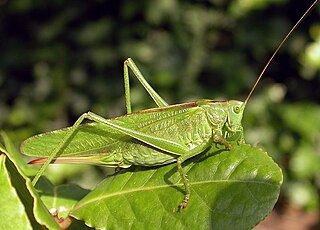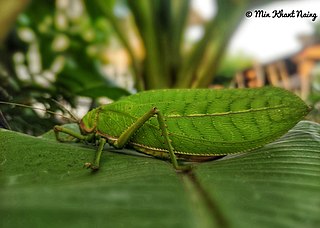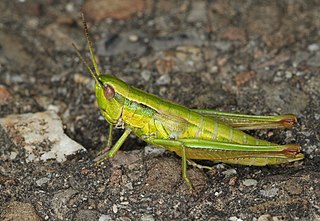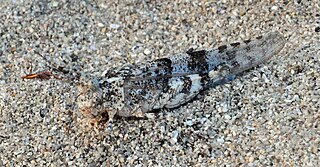
Ectobiidae is a family of the order Blattodea (cockroaches). This family contains many of the smaller common household pest cockroaches, among others. They are sometimes called wood cockroaches. A few notable species include:

Bandwings, or band-winged grasshoppers, are the subfamily Oedipodinae of grasshoppers classified under the family Acrididae. They have a worldwide distribution and were originally elevated to full family status as the Oedipodidae. Many species primarily inhabit xeric weedy fields, and some are considered to be important locusts:

The grasshopper subfamily Acridinae, sometimes called silent slant-faced grasshoppers, belong of the large family Acrididae in the Orthoptera: Caelifera.

The Tettigoniinae are a subfamily of bush crickets or katydids, which contains hundreds of species in about twelve tribes.

Isophya is a genus of bush crickets, in the tribe Barbitistini, found from mainland Europe to western Asia.

The subfamily Pseudophyllinae contains numerous species in the family Tettigoniidae, the katydids or bush crickets. Sometimes called "true katydids", together with the crickets of suborder Ensifera, they form part of the insect order Orthoptera which also contains grasshoppers.

The Phaneropterinae, the sickle-bearing bush crickets or leaf katydids, are a subfamily of insects within the family Tettigoniidae. Nearly 2,060 species in 85 genera throughout the world are known. They are also known as false katydids or round-headed katydids.

Gomphocerinae, sometimes called "slant-faced grasshoppers", are a subfamily of grasshoppers found on every continent but Antarctica and Australia.

Oedipoda is the type genus of grasshoppers, in the subfamily Oedipodinae, mostly from the Palaearctic realm. The type species is the European "blue-winged grasshopper", Oedipoda caerulescens.

Meconematinae is a subfamily of the bush crickets, with a worldwide distribution.

Pamphagidae is a family of grasshoppers belonging to the superfamily Acridoidea. The species in this family can be found in Africa, Europe and Asia.

Dociostaurus is a genus of grasshoppers in the family Acrididae, subfamily Gomphocerinae and typical of the tribe Dociostaurini. Species are found in Africa, southern Europe and Asia, and includes the economically important Moroccan locust.

Sphingonotus is a genus of grasshoppers in the family Acrididae, subfamily Oedipodinae, found in Europe Africa, Asia and Australia.

Pamphaginae is a subfamily of grasshoppers in the family Pamphagidae, with species found in Africa, Europe and Asia.
Iranotmethis is a genus of grasshopers in the subfamily Thrinchinae, with species found in Iran.
The Egnatiinae are a subfamily of grasshoppers in the family Acrididae, found in central and South America, and based on the monotypic type genus Egnatius and erected by Bey-Bienko in 1951. Species have been recorded from parts of Africa, the Middle East and Asia, including Russia and China.

Ochrilidia is a genus of grasshoppers in the subfamily Gomphocerinae and typical of the tribe Ochrilidiini; it was erected by Carl Stål in 1873. Species have been recorded from Africa, the Middle East through to India and certain Mediterranean islands in Europe.

Phyllodromica is a genus of mostly Palaearctic cockroaches in the subfamily Ectobiinae, erected by Franz Xaver Fieber in 1853. The recorded distribution for species includes: mainland Europe, North Africa, the Middle East through to central Asia.

















